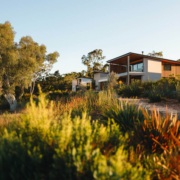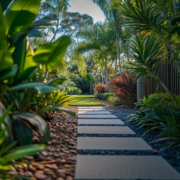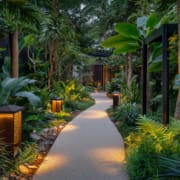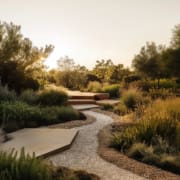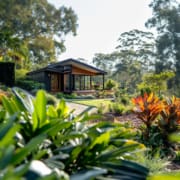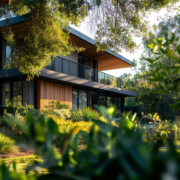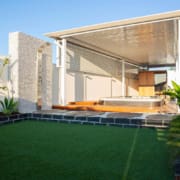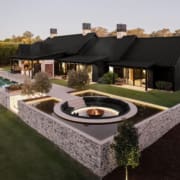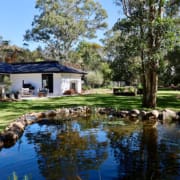Innovative Hardscaping Ideas for Brisbane Homes
Hardscaping involves the use of non-plant elements in landscape design, such as patios, walkways, and retaining walls. For Brisbane homes, where the subtropical climate and diverse outdoor spaces offer unique opportunities, innovative hardscaping can significantly enhance the functionality and aesthetic appeal of your property. This guide explores creative hardscaping ideas that can transform your Brisbane home into a stylish and functional outdoor haven.
1. Create Functional Outdoor Living Spaces
Expanding your living area outdoors can offer both comfort and style.
Custom Decks and Patios
- Timber Decking: Install a custom timber deck to create a warm and inviting space for outdoor entertaining. Choose from a variety of woods and finishes to match your home’s aesthetic.
- Paved Patios: Opt for high-quality pavers, such as natural stone or concrete, to construct a durable and attractive patio area. Consider patterns like herringbone or basket weave for added visual interest.
Outdoor Kitchens and Dining Areas
- Built-In BBQs: Incorporate a built-in BBQ or outdoor kitchen with features like a stone countertop, sink, and storage. This setup makes outdoor cooking and dining more enjoyable and convenient.
- Dining Spaces: Create a dedicated outdoor dining area with weather-resistant furniture and a stylish pergola or shade structure to enhance the dining experience.
2. Design Eye-Catching Pathways and Driveways
Well-designed pathways and driveways not only improve functionality but also contribute to the overall aesthetics of your garden.
Decorative Pathways
- Natural Stone Paths: Use natural stone, such as slate or sandstone, to create a visually appealing and durable pathway that complements your garden’s style.
- Stepping Stones: Incorporate stepping stones surrounded by ground covers or gravel to create a whimsical and inviting walkway.
Stylish Driveways
- Exposed Aggregate Concrete: Opt for exposed aggregate concrete for a textured and modern look. This finish is both durable and low-maintenance.
- Patterned Pavers: Choose patterned pavers or brickwork to add character and charm to your driveway. Consider alternating colours or designs for a unique effect.
3. Incorporate Retaining Walls for Function and Beauty
Retaining walls can provide essential structural support while enhancing the visual appeal of your garden.
Natural Stone Walls
- Classic Stone Walls: Construct natural stone retaining walls to add a timeless and elegant touch to your landscape. Stone walls can be used to create terraced garden beds or define different garden areas.
- Dry-Stone Walls: For a rustic look, consider dry-stone walls that use carefully placed stones without mortar, providing a natural and organic feel.
Modular and Timber Walls
- Modular Block Walls: Use modular concrete blocks for a sleek and contemporary retaining wall solution. These blocks come in various sizes and colours, allowing for versatile design options.
- Timber Retaining Walls: Incorporate timber retaining walls for a warm and rustic look. Choose durable and treated timber to withstand the elements and maintain longevity.
4. Add Functional and Aesthetic Water Features
Water features can serve as focal points in your garden while providing relaxation and tranquillity.
Fountains and Waterfalls
- Garden Fountains: Install a decorative garden fountain to create a serene atmosphere with the soothing sound of flowing water. Options include tiered fountains or modern sculptural designs.
- Waterfalls: Incorporate a cascading waterfall to add drama and elegance to your garden. Use natural stones and integrate the waterfall into a pond or stream for a cohesive look.
Ponds and Streams
- Koi Ponds: Create a koi pond with aquatic plants and fish to add beauty and a touch of luxury to your outdoor space.
- Artificial Streams: Design artificial streams with rocks and gravel to mimic the look of a natural creek, enhancing the overall aesthetic of your garden.
5. Elevate Your Garden with Unique Fire Features
Fire features can provide warmth and ambiance, making your outdoor space enjoyable year-round.
Fire Pits
- Built-In Fire Pits: Construct a built-in fire pit using materials like stone or brick for a permanent and stylish addition to your garden. Arrange seating around the fire pit for a cosy gathering spot.
- Modern Fire Bowls: Opt for sleek and contemporary fire bowls or fire tables for a modern twist. These features can serve as both a functional and decorative element.
Outdoor Fireplaces
- Stone Fireplaces: Build a stone outdoor fireplace to create a focal point and provide a classic and elegant atmosphere for your outdoor area.
- Gas Fireplaces: Choose a gas fireplace for convenience and a clean-burning option. Gas fireplaces offer easy operation and require less maintenance compared to wood-burning options.
6. Integrate Sustainable Hardscaping Elements
Sustainable hardscaping practices not only benefit the environment but also enhance the efficiency and longevity of your outdoor features.
Permeable Pavers
- Drainage Solutions: Use permeable pavers to improve water drainage and reduce runoff. These pavers allow water to seep through and be absorbed by the soil, minimizing erosion and promoting groundwater recharge.
Recycled Materials
- Recycled Bricks and Stones: Incorporate recycled bricks or reclaimed stone into your hardscaping projects to reduce waste and add unique character to your design.
- Eco-Friendly Products: Opt for eco-friendly sealants and finishes that have minimal environmental impact while maintaining the beauty and durability of your hardscaping elements.
7. Enhance Your Garden with Creative Lighting
Proper lighting can highlight hardscaping features and create a welcoming ambiance in your garden.
Pathway and Accent Lighting
- LED Path Lights: Install LED path lights along walkways and driveways to ensure safety and enhance the visual appeal of your garden at night.
- Accent Lights: Use accent lighting to highlight key features like statues, water features, or architectural elements, adding depth and interest to your outdoor space.
Ambient and Task Lighting
- Outdoor Chandeliers: Hang outdoor chandeliers or pendant lights in covered areas to provide ambient lighting and create an elegant atmosphere.
- Task Lighting: Incorporate task lighting in outdoor kitchens and dining areas to ensure functionality and visibility during evening gatherings.
8. Create Multi-Level Outdoor Spaces
Multi-level hardscaping can add dimension and functionality to your garden, making it more engaging and versatile.
Terraced Gardens
- Garden Terraces: Design terraced garden beds using retaining walls to create distinct planting areas and manage slopes or elevation changes.
- Outdoor Rooms: Create separate outdoor rooms or zones for dining, lounging, or play, using steps and retaining walls to define each area.
Elevated Decks and Patios
- Raised Decks: Construct raised decks to offer expansive views and create a designated area for outdoor living. This approach works well on sloped or uneven terrain.
- Sunken Patios: Design sunken patios or seating areas to create a cosy and intimate space while making use of existing landscape contours.
Innovative hardscaping can transform your Brisbane home into a stylish and functional outdoor oasis. By incorporating features like custom decks, decorative pathways, retaining walls, water features, fire elements, and sustainable practices, you can create an outdoor space that enhances both the beauty and value of your property. For expert advice and high-quality hardscaping solutions, contact Live Outdoors. Our team is dedicated to delivering exceptional results tailored to your unique needs and preferences.
